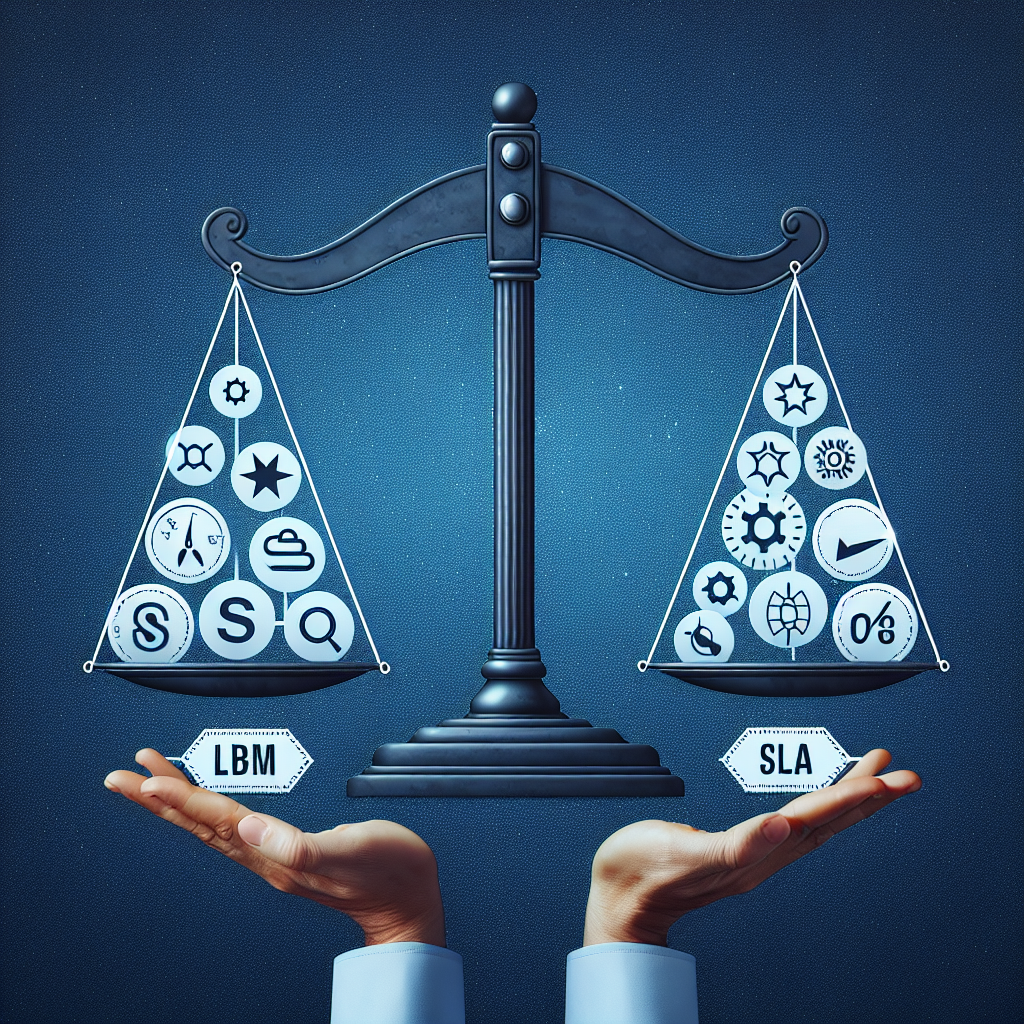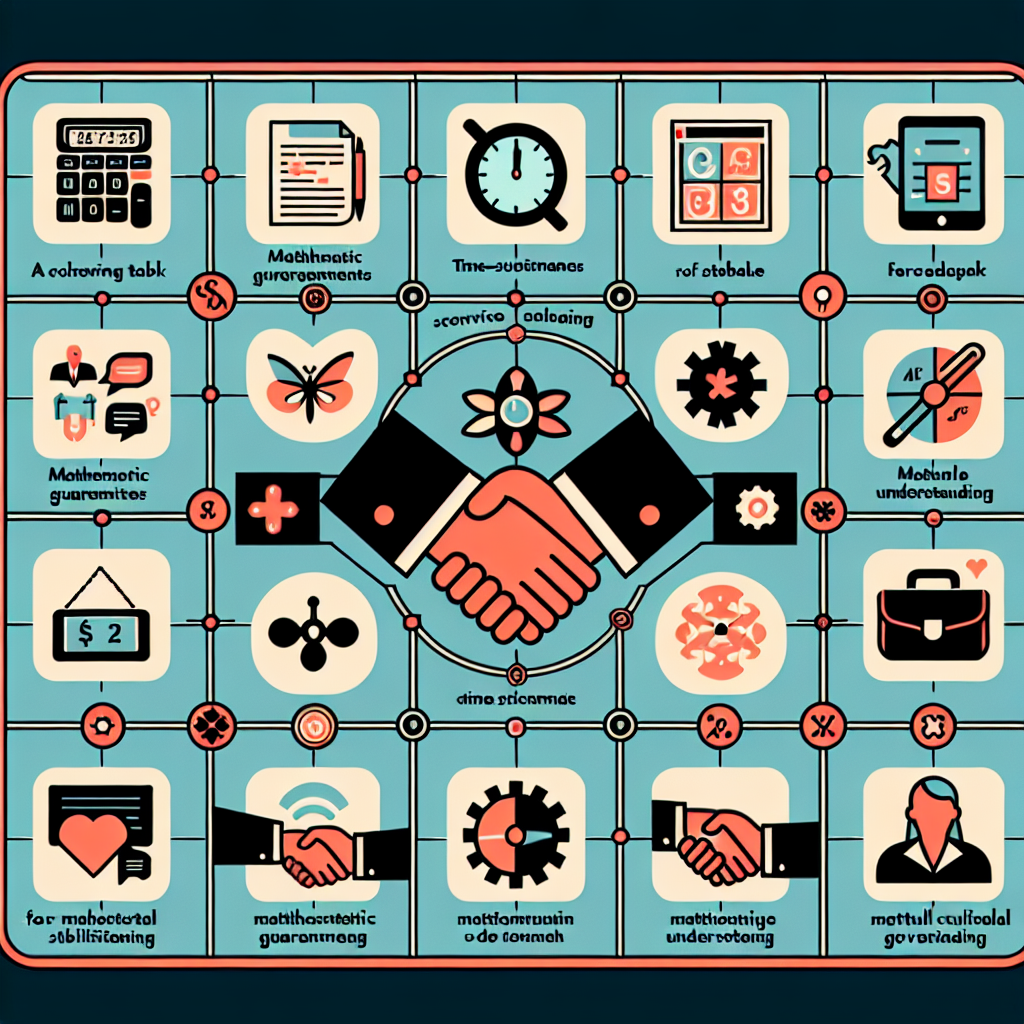Your cart is currently empty!
Tag: Strong

The Key Elements of a Strong Service Level Agreement (SLA)
A Service Level Agreement (SLA) is a crucial document that outlines the expectations and responsibilities of both the service provider and the client. It serves as a contract that sets the standards for the services provided and ensures that both parties are on the same page regarding the level of service that will be delivered.To ensure that your SLA is effective and comprehensive, there are several key elements that should be included:
1. Service Scope: The SLA should clearly define the scope of services that will be provided, including what services are included and excluded. This helps to avoid any misunderstandings about what is covered under the agreement.
2. Service Level Objectives (SLOs): SLOs are measurable targets that define the level of service that will be provided. These should be realistic and achievable, and should be clearly defined in the SLA.
3. Performance Metrics: The SLA should include specific performance metrics that will be used to measure the service provider’s performance. These metrics could include response times, resolution times, uptime, and availability.
4. Responsibilities: The responsibilities of both the service provider and the client should be clearly outlined in the SLA. This includes who is responsible for what tasks, how communication will be handled, and how issues will be escalated.
5. Service Level Credits: In the event that the service provider fails to meet the agreed-upon service levels, the SLA should outline what compensation or credits will be provided to the client.
6. Reporting and Review Process: The SLA should include a process for regular reporting and review of performance metrics. This ensures that both parties are aware of how the service is performing and allows for any necessary adjustments to be made.
7. Termination Clause: In the event that either party wishes to terminate the agreement, the SLA should include a clause that outlines the process for termination and any associated penalties.
By including these key elements in your SLA, you can ensure that both parties have a clear understanding of the services that will be provided and the expectations that need to be met. This can help to prevent misunderstandings, improve communication, and ensure that the service provided meets the needs of the client.

How to Create a Strong Service Level Agreement for Your Business
A Service Level Agreement (SLA) is a crucial document that outlines the expectations and responsibilities between a business and its service provider. It is essential for ensuring that both parties are on the same page and understand what is expected of them. Creating a strong SLA is important for protecting your business and ensuring that you receive the services you need. Here are some tips on how to create a strong SLA for your business.1. Define the services: The first step in creating a strong SLA is to clearly define the services that will be provided. This includes detailing what services are included, the scope of the services, and any limitations or exclusions. Be specific about what is expected from the service provider and what the deliverables will be.
2. Set clear performance metrics: In order to measure the performance of the service provider, it is important to set clear and measurable performance metrics. This could include things like response times, uptime guarantees, and resolution times. Make sure that these metrics are realistic and achievable.
3. Include penalties for non-compliance: To ensure that the service provider meets their obligations, it is important to include penalties for non-compliance in the SLA. This could include financial penalties or termination of the agreement. Make sure that these penalties are fair and reasonable.
4. Establish a communication plan: Communication is key in any business relationship, so it is important to establish a communication plan in the SLA. This should outline how often communication will occur, who the point of contact will be, and how issues will be escalated and resolved.
5. Review and update regularly: Once the SLA is in place, it is important to regularly review and update it to ensure that it remains relevant and effective. As your business changes and grows, so too should your SLA. Make sure to involve all relevant stakeholders in the review process.
In conclusion, creating a strong SLA for your business is essential for ensuring that you receive the services you need and that both parties understand their responsibilities. By following these tips, you can create a strong SLA that will protect your business and help you achieve your goals.

How to Build a Strong Cybersecurity Strategy
In today’s digital age, cybersecurity has become a top priority for businesses of all sizes. With cyber threats becoming more sophisticated and frequent, it is essential for companies to have a strong cybersecurity strategy in place to protect their sensitive data and information. Here are some key steps to help you build a robust cybersecurity strategy for your organization.1. Understand your risks:
The first step in building a strong cybersecurity strategy is to understand the potential risks and threats that your organization faces. Conduct a thorough risk assessment to identify vulnerabilities in your systems and processes, as well as the potential impact of a cyber attack on your business. This will help you prioritize your security efforts and allocate resources effectively.
2. Implement strong security measures:
Once you have identified the risks, it is important to implement strong security measures to protect your organization from cyber threats. This may include deploying firewalls, antivirus software, encryption tools, and multi-factor authentication to safeguard your data and systems. Regularly update your security software and patch vulnerabilities to stay ahead of cyber attackers.
3. Educate your employees:
One of the weakest links in cybersecurity is often human error. Train your employees on best practices for cybersecurity, such as creating strong passwords, avoiding phishing scams, and reporting suspicious activity. Encourage a culture of security awareness within your organization to help prevent data breaches and cyber attacks.
4. Monitor and detect threats:
In addition to implementing security measures, it is important to continuously monitor your systems for any signs of suspicious activity. Use intrusion detection systems, log monitoring, and security analytics tools to detect and respond to potential threats in real-time. Establish incident response procedures to quickly contain and mitigate the impact of a cyber attack.
5. Regularly assess and update your strategy:
Cyber threats are constantly evolving, so it is essential to regularly assess and update your cybersecurity strategy to stay ahead of potential risks. Conduct regular security audits, penetration testing, and vulnerability assessments to identify any weaknesses in your defenses and make necessary improvements. Stay informed about the latest cybersecurity trends and technologies to ensure your strategy remains effective.
By following these key steps, you can build a strong cybersecurity strategy to protect your organization from cyber threats and safeguard your sensitive data. Remember that cybersecurity is an ongoing process, and it requires constant vigilance and proactive measures to mitigate risks effectively. Prioritize cybersecurity within your organization and invest in the necessary resources to ensure the security of your business operations.

Building a Strong Foundation: Creating a Comprehensive Disaster Recovery Strategy
Disasters can strike at any time, and without warning. Whether it’s a natural disaster like a hurricane or earthquake, or a man-made disaster such as a cyberattack or data breach, businesses need to be prepared for the worst. Building a strong foundation by creating a comprehensive disaster recovery strategy is essential for ensuring business continuity and minimizing the impact of a disaster on your organization.A disaster recovery strategy is a plan that outlines how a business will respond to and recover from a disaster. It includes processes, procedures, and technologies that are put in place to ensure that critical business functions can continue to operate in the event of a disaster. A comprehensive disaster recovery strategy should address all aspects of the business, including IT systems, data, communication, and personnel.
The first step in creating a comprehensive disaster recovery strategy is to conduct a risk assessment. This involves identifying potential threats and vulnerabilities that could impact your business, and assessing the potential impact of these threats on your operations. Once you have identified the risks, you can then prioritize them based on their likelihood and potential impact, and develop a plan to mitigate these risks.
One of the key components of a disaster recovery strategy is data backup and recovery. It is essential to regularly back up all critical data and systems to ensure that your business can quickly recover in the event of a disaster. This includes storing backups off-site or in the cloud to ensure that they are safe from physical damage. Regularly testing your backups to ensure they are up-to-date and accessible is also crucial.
Another important aspect of a disaster recovery strategy is communication. It is essential to have a plan in place for communicating with employees, customers, and other stakeholders in the event of a disaster. This includes establishing communication channels and protocols, as well as providing regular updates and information on the status of recovery efforts.
Training and preparedness are also key components of a comprehensive disaster recovery strategy. It is essential to ensure that employees are trained on their roles and responsibilities in the event of a disaster, and that they are prepared to respond quickly and effectively. Conducting regular drills and exercises can help to ensure that everyone knows what to do in an emergency.
In conclusion, building a strong foundation by creating a comprehensive disaster recovery strategy is essential for ensuring business continuity and minimizing the impact of a disaster on your organization. By conducting a risk assessment, implementing data backup and recovery plans, establishing communication protocols, and providing training and preparedness, you can ensure that your business is well-equipped to respond to any disaster that may come its way.

Building a Strong Customer Service Culture in Your Help Desk
Building a strong customer service culture in your help desk is crucial for the success of your business. A positive customer service experience can make or break a customer’s perception of your company, and can have a significant impact on customer retention and loyalty. Here are some tips on how to build a strong customer service culture in your help desk:1. Hire the right people: When building a customer service culture, it is important to hire employees who are not only skilled in technical support, but also have strong communication and interpersonal skills. Look for candidates who are empathetic, patient, and able to handle difficult situations with professionalism and grace.
2. Train and empower your employees: Once you have hired the right people, it is crucial to provide them with the necessary training and support to excel in their roles. This includes technical training on your products and services, as well as customer service training on how to effectively communicate with customers and resolve issues in a timely manner. Empower your employees to make decisions and take ownership of customer interactions, rather than relying on rigid scripts or protocols.
3. Set clear expectations and goals: Clearly define your customer service expectations and goals, and communicate them to your team. This will help ensure that everyone is on the same page and working towards a common objective. Regularly review and track progress towards these goals, and provide feedback and support to help your team succeed.
4. Foster a positive work environment: A positive work environment can have a significant impact on employee morale and performance. Encourage open communication, collaboration, and teamwork among your team members. Recognize and reward employees for their hard work and dedication, and provide opportunities for professional development and growth.
5. Solicit feedback and continuously improve: Customer service is an ongoing process that requires constant evaluation and improvement. Encourage feedback from both customers and employees, and use this feedback to identify areas for improvement and implement changes as needed. Regularly review customer service metrics and KPIs to ensure that you are meeting or exceeding customer expectations.
By following these tips, you can build a strong customer service culture in your help desk that will set your business apart from the competition and help you retain satisfied customers for years to come. Remember, a positive customer service experience can be a powerful tool for building brand loyalty and driving business growth.

Building Resilience: Key Components of a Strong Business Continuity Plan
In today’s rapidly changing and unpredictable business environment, it is more important than ever for companies to have a strong business continuity plan in place. A business continuity plan is a proactive strategy that helps organizations prepare for and respond to potential disruptions, such as natural disasters, cyber attacks, or other unforeseen events that could threaten the operations of the business.Building resilience is a key component of a strong business continuity plan. Resilience refers to the ability of an organization to adapt, recover, and thrive in the face of adversity. By building resilience into their business continuity plan, companies can better prepare for and respond to disruptions, minimize the impact on their operations, and ensure the long-term sustainability of their business.
There are several key components of a strong business continuity plan that can help companies build resilience and ensure their ability to withstand and recover from disruptions. These include:
1. Risk assessment and mitigation: The first step in building resilience is to identify and assess potential risks that could impact the business. This includes conducting a thorough risk assessment to identify vulnerabilities and develop strategies to mitigate these risks. By understanding the potential threats to their operations, companies can better prepare for and respond to disruptions when they occur.
2. Business impact analysis: A business impact analysis helps companies understand the potential impact of disruptions on their operations, including financial losses, reputational damage, and regulatory compliance issues. By conducting a business impact analysis, companies can prioritize their response efforts and allocate resources more effectively to minimize the impact of disruptions.
3. Continuity planning: Developing a comprehensive continuity plan is essential for building resilience. This plan should outline the steps that the company will take to ensure the continued operation of critical business functions in the event of a disruption. This may include establishing backup systems, implementing redundant processes, and developing communication protocols to keep employees, customers, and stakeholders informed during a crisis.
4. Training and testing: Building resilience also requires ongoing training and testing of the business continuity plan. This helps ensure that employees are prepared to respond effectively to disruptions and that the plan is up-to-date and effective. Regular training exercises and drills can help identify gaps in the plan and provide opportunities for improvement.
5. Communication and coordination: Effective communication is essential for building resilience. Companies should establish clear communication protocols to ensure that employees, customers, and stakeholders receive timely and accurate information during a disruption. Coordination with external partners, such as suppliers, vendors, and regulatory agencies, is also important to ensure a coordinated response to a crisis.
By incorporating these key components into their business continuity plan, companies can build resilience and enhance their ability to adapt, recover, and thrive in the face of adversity. Building resilience is not only essential for ensuring the long-term sustainability of a business but also for protecting its reputation, brand, and relationships with customers and stakeholders. Investing in a strong business continuity plan that prioritizes resilience can help companies navigate and overcome the challenges of an increasingly complex and unpredictable business environment.

Why Every Organization Needs a Strong Cybersecurity Strategy
In today’s digital age, the importance of having a strong cybersecurity strategy cannot be overstated. With cyber threats becoming increasingly sophisticated and pervasive, organizations of all sizes and industries are at risk of falling victim to cyber attacks. From data breaches to ransomware attacks, the consequences of a security breach can be devastating, leading to financial losses, reputational damage, and legal ramifications.One of the key reasons why every organization needs a strong cybersecurity strategy is to protect sensitive data. In today’s data-driven world, organizations collect and store a vast amount of sensitive information, including customer data, financial records, and intellectual property. A security breach can result in this information falling into the wrong hands, leading to identity theft, financial fraud, and other forms of cybercrime. By implementing robust cybersecurity measures, organizations can safeguard their data and prevent unauthorized access.
Furthermore, a strong cybersecurity strategy is essential for maintaining the trust and confidence of customers, partners, and stakeholders. In the event of a security breach, organizations risk damaging their reputation and losing the trust of their clients. This can have far-reaching consequences, including loss of business, negative publicity, and legal action. By prioritizing cybersecurity, organizations can demonstrate their commitment to protecting sensitive information and ensuring the security and privacy of their stakeholders.
In addition, a strong cybersecurity strategy is essential for complying with regulatory requirements and industry standards. With the increasing number of data protection laws and regulations, such as the General Data Protection Regulation (GDPR) and the California Consumer Privacy Act (CCPA), organizations are under increasing pressure to protect the privacy and security of personal data. Failure to comply with these regulations can result in hefty fines and penalties, as well as damage to the organization’s reputation. By implementing a robust cybersecurity strategy, organizations can ensure compliance with regulatory requirements and avoid legal consequences.
Overall, investing in a strong cybersecurity strategy is essential for protecting sensitive data, maintaining trust and confidence, and complying with regulatory requirements. With cyber threats on the rise, organizations cannot afford to be complacent when it comes to cybersecurity. By prioritizing cybersecurity and implementing best practices, organizations can mitigate the risks of cyber attacks and safeguard their data and reputation. Ultimately, a strong cybersecurity strategy is crucial for the long-term success and sustainability of any organization in today’s digital landscape.

Building a Strong Disaster Recovery Team: Key Roles and Responsibilities
Disasters can strike at any moment, whether it be a natural disaster like a hurricane or earthquake, or a man-made disaster such as a cyber attack or fire. In order to effectively respond and recover from these disasters, organizations must have a strong disaster recovery team in place.Building a strong disaster recovery team involves identifying key roles and responsibilities that are essential for a successful response and recovery effort. Here are some key roles that should be included in a disaster recovery team, along with their respective responsibilities:
1. Incident Commander: The incident commander is responsible for overseeing the entire response and recovery effort. They are in charge of making strategic decisions, coordinating resources, and communicating with key stakeholders. The incident commander must have strong leadership skills and be able to make quick and effective decisions under pressure.
2. IT Manager: The IT manager is responsible for managing the organization’s IT systems and ensuring that they are properly backed up and secured. In the event of a disaster, the IT manager will be responsible for restoring IT systems and data, as well as implementing security measures to prevent further damage.
3. Communications Coordinator: The communications coordinator is responsible for managing internal and external communications during a disaster. This includes keeping employees informed about the situation, coordinating with the media, and communicating with customers and suppliers. The communications coordinator must have strong communication skills and be able to convey information clearly and effectively.
4. Operations Manager: The operations manager is responsible for coordinating the organization’s response and recovery efforts on the ground. This includes managing logistics, coordinating resources, and ensuring that critical operations are up and running as quickly as possible. The operations manager must have strong organizational skills and be able to work well under pressure.
5. Human Resources Coordinator: The human resources coordinator is responsible for managing the organization’s workforce during a disaster. This includes ensuring the safety and well-being of employees, coordinating employee communications, and providing support for employees who may be affected by the disaster. The human resources coordinator must have strong interpersonal skills and be able to provide support and guidance to employees during a difficult time.
Building a strong disaster recovery team requires careful planning and preparation. By identifying key roles and responsibilities, organizations can ensure that they have the right team in place to effectively respond and recover from any disaster that may come their way. With a strong disaster recovery team in place, organizations can minimize the impact of disasters and ensure a swift and successful recovery.

Building a Strong Foundation: Implementing Effective Business Continuity Measures for Long-Term Success
In today’s unpredictable business environment, it is more important than ever for companies to have a strong foundation in place to ensure long-term success. One key component of this foundation is implementing effective business continuity measures. Business continuity planning involves creating a strategy to ensure that essential business functions can continue to operate in the event of a disruption or disaster.Building a strong foundation for business continuity starts with assessing potential risks and vulnerabilities that could impact your organization. This includes identifying potential threats such as natural disasters, cyber-attacks, supply chain disruptions, and pandemics. By understanding these risks, companies can develop a comprehensive plan to mitigate their impact and ensure that critical operations can continue in the face of adversity.
One important aspect of business continuity planning is developing a robust communication strategy. In the event of a crisis, it is essential to have clear lines of communication in place to keep employees, customers, and stakeholders informed. This includes establishing communication protocols, identifying key stakeholders, and ensuring that all employees are trained on how to respond in an emergency.
Another key component of effective business continuity planning is establishing backup systems and redundancies. This includes implementing backup power sources, data storage solutions, and alternative work locations to ensure that operations can continue even in the face of a major disruption. By having these systems in place, companies can minimize downtime and maintain business continuity during a crisis.
It is also important for companies to regularly test and update their business continuity plans. By conducting regular drills and exercises, organizations can identify gaps in their strategy and make necessary adjustments to improve their response to a crisis. In addition, it is important to review and update the plan regularly to account for changes in the business environment, such as new technologies or regulations.
Overall, implementing effective business continuity measures is essential for long-term success. By building a strong foundation through risk assessment, communication planning, backup systems, and testing, companies can ensure that they are prepared to weather any storm and continue to thrive in the face of adversity. By investing in business continuity planning, companies can protect their assets, reputation, and bottom line, ultimately contributing to their long-term success.

10 Key Components of a Strong Service Level Agreement
A Service Level Agreement (SLA) is a crucial document that outlines the expectations and responsibilities between a service provider and a customer. A strong SLA ensures that both parties are on the same page and have a clear understanding of the services being provided. Here are 10 key components that should be included in a strong SLA:1. Service Scope: The SLA should clearly define the services being provided, including the scope, limitations, and any specific requirements.
2. Service Level Objectives: The SLA should outline the expected service levels, such as uptime, response times, and resolution times.
3. Performance Metrics: The SLA should include specific metrics for measuring the performance of the services, such as availability, reliability, and response times.
4. Responsibilities: The SLA should clearly outline the responsibilities of both the service provider and the customer, including any specific tasks or obligations.
5. Escalation Procedures: The SLA should include escalation procedures in case of any issues or disputes, including who to contact and how to resolve the issue.
6. Service Credits: The SLA should outline any service credits or penalties that may be incurred if the service provider fails to meet the agreed-upon service levels.
7. Reporting: The SLA should include reporting requirements, including how often reports will be provided and what information will be included.
8. Change Management: The SLA should outline the process for making changes to the services, including how changes will be requested, approved, and implemented.
9. Termination: The SLA should include terms for termination, including how either party can terminate the agreement and any penalties for early termination.
10. Compliance: The SLA should outline any compliance requirements, such as security standards, data protection regulations, or industry-specific regulations.
In conclusion, a strong SLA is essential for establishing clear expectations and ensuring that both parties are accountable for meeting their obligations. By including these key components in an SLA, both the service provider and the customer can have confidence in the services being provided and maintain a positive and productive working relationship.
